正则表达式 Regular Expression 例子 sample VB版
excel中使用正则

excel中使用正则在Excel中,可以使用正则表达式(Regular Expression)来进行文本的匹配、查找和替换等操作。
正则表达式是一种强大的模式匹配工具,可以根据特定的规则来匹配和处理文本。
要在Excel中使用正则表达式,你可以借助VBA(VisualBasic for Applications)编程语言来实现。
下面是一个简单的示例,演示了如何在Excel中使用正则表达式来查找和替换文本:1. 首先,打开Excel并按下Alt + F11进入VBA编辑器。
2. 在VBA编辑器中,插入一个新的模块(Insert -> Module)。
3. 在模块中编写以下代码:vba.Sub RegexExample()。
Dim regex As Object.Dim inputString As String.Dim pattern As String.Dim replacement As String.' 创建正则表达式对象。
Set regex = CreateObject("VBScript.RegExp")。
' 设置要匹配的字符串。
inputString = "Hello, World!"' 设置正则表达式模式。
pattern = "World"' 设置替换字符串。
replacement = "Universe"' 设置正则表达式对象的属性。
With regex..Global = True ' 全局匹配。
.IgnoreCase = True ' 忽略大小写。
.pattern = pattern ' 设置模式。
End With.' 执行替换操作。
outputString = regex.Replace(inputString, replacement)。
正则表达式例子详解
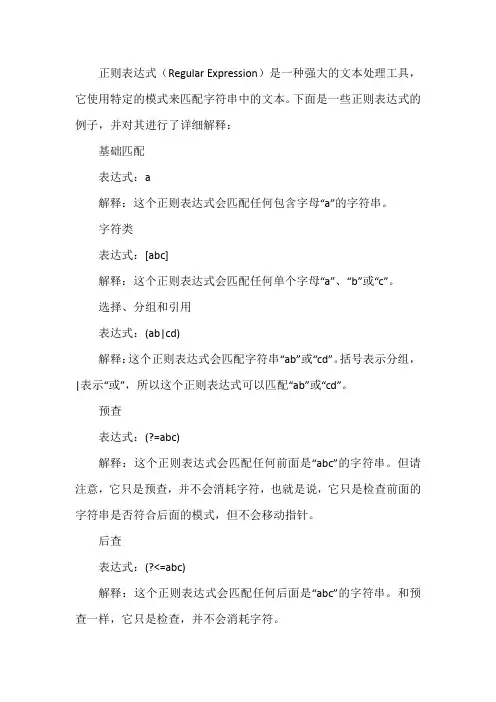
正则表达式(Regular Expression)是一种强大的文本处理工具,它使用特定的模式来匹配字符串中的文本。
下面是一些正则表达式的例子,并对其进行了详细解释:基础匹配表达式:a解释:这个正则表达式会匹配任何包含字母“a”的字符串。
字符类表达式:[abc]解释:这个正则表达式会匹配任何单个字母“a”、“b”或“c”。
选择、分组和引用表达式:(ab|cd)解释:这个正则表达式会匹配字符串“ab”或“cd”。
括号表示分组,|表示“或”,所以这个正则表达式可以匹配“ab”或“cd”。
预查表达式:(?=abc)解释:这个正则表达式会匹配任何前面是“abc”的字符串。
但请注意,它只是预查,并不会消耗字符,也就是说,它只是检查前面的字符串是否符合后面的模式,但不会移动指针。
后查表达式:(?<=abc)解释:这个正则表达式会匹配任何后面是“abc”的字符串。
和预查一样,它只是检查,并不会消耗字符。
非贪婪匹配表达式:a.*?b解释:这个正则表达式会匹配第一个出现的“b”之前的所有“a”。
点号(.)表示任何字符,星号(*)表示前面的元素可以重复0次或多次,问号(?)表示非贪婪匹配,也就是说它会尽可能少地匹配字符。
所以,这个正则表达式会匹配从第一个“a”到第一个“b”之间的所有字符。
特殊字符表达式:\d解释:这个正则表达式会匹配任何数字。
反斜杠(\)是一个转义字符,所以\d表示数字。
类似的,还有例如\w(匹配任何字母、数字或下划线),\s(匹配任何空白字符),等等。
数量词表达式:a{3,5}解释:这个正则表达式会匹配3个、4个或5个连续的“a”。
大括号表示数量词,它可以指定前面的元素必须出现的次数范围。
锚点表达式:^abc$解释:这个正则表达式只会匹配整个字符串“abc”。
脱字符(^)表示字符串的开始,美元符号($)表示字符串的结束。
所以这个正则表达式只会匹配一个只包含“abc”的字符串。
修饰符表达式:/i(在某些语言中)解释:这个修饰符使匹配对大小写不敏感。
vb正则表达式
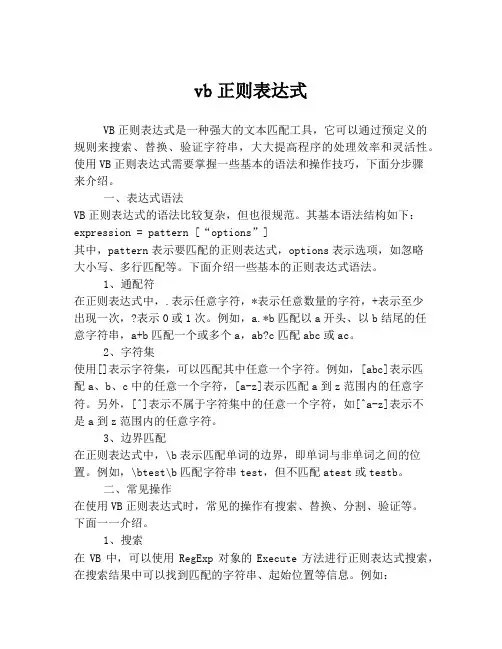
vb正则表达式VB正则表达式是一种强大的文本匹配工具,它可以通过预定义的规则来搜索、替换、验证字符串,大大提高程序的处理效率和灵活性。
使用VB正则表达式需要掌握一些基本的语法和操作技巧,下面分步骤来介绍。
一、表达式语法VB正则表达式的语法比较复杂,但也很规范。
其基本语法结构如下:expression = pattern [“options”]其中,pattern表示要匹配的正则表达式,options表示选项,如忽略大小写、多行匹配等。
下面介绍一些基本的正则表达式语法。
1、通配符在正则表达式中,.表示任意字符,*表示任意数量的字符,+表示至少出现一次,?表示0或1次。
例如,a.*b匹配以a开头、以b结尾的任意字符串,a+b匹配一个或多个a,ab?c匹配abc或ac。
2、字符集使用[]表示字符集,可以匹配其中任意一个字符。
例如,[abc]表示匹配a、b、c中的任意一个字符,[a-z]表示匹配a到z范围内的任意字符。
另外,[^]表示不属于字符集中的任意一个字符,如[^a-z]表示不是a到z范围内的任意字符。
3、边界匹配在正则表达式中,\b表示匹配单词的边界,即单词与非单词之间的位置。
例如,\btest\b匹配字符串test,但不匹配atest或testb。
二、常见操作在使用VB正则表达式时,常见的操作有搜索、替换、分割、验证等。
下面一一介绍。
1、搜索在VB中,可以使用RegExp对象的Execute方法进行正则表达式搜索,在搜索结果中可以找到匹配的字符串、起始位置等信息。
例如:Dim RegEx As New RegExpRegEx.Pattern = "abc"Set Matches = RegEx.Execute("abcdef")For Each Match In MatchesMsgBox "Match found at position " & Match.FirstIndexNext以上代码表示在字符串abcdef中搜索abc,对于每个匹配结果,弹出一个提示框显示其起始位置。
VBA 中的正则表达式应用与实例讲解
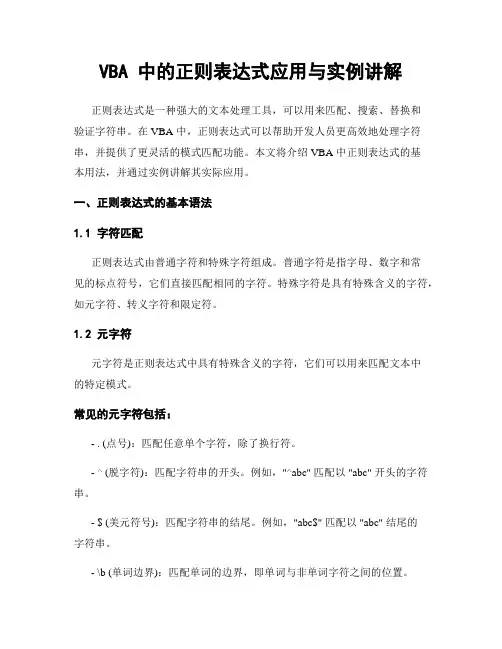
VBA 中的正则表达式应用与实例讲解正则表达式是一种强大的文本处理工具,可以用来匹配、搜索、替换和验证字符串。
在 VBA 中,正则表达式可以帮助开发人员更高效地处理字符串,并提供了更灵活的模式匹配功能。
本文将介绍 VBA 中正则表达式的基本用法,并通过实例讲解其实际应用。
一、正则表达式的基本语法1.1 字符匹配正则表达式由普通字符和特殊字符组成。
普通字符是指字母、数字和常见的标点符号,它们直接匹配相同的字符。
特殊字符是具有特殊含义的字符,如元字符、转义字符和限定符。
1.2 元字符元字符是正则表达式中具有特殊含义的字符,它们可以用来匹配文本中的特定模式。
常见的元字符包括:- . (点号):匹配任意单个字符,除了换行符。
- ^ (脱字符):匹配字符串的开头。
例如,"^abc" 匹配以 "abc" 开头的字符串。
- $ (美元符号):匹配字符串的结尾。
例如,"abc$" 匹配以 "abc" 结尾的字符串。
- \b (单词边界):匹配单词的边界,即单词与非单词字符之间的位置。
1.3 转义字符转义字符用来取消元字符的特殊含义,使其失去特殊含义并按照字面意义进行匹配。
常见的转义字符包括:- \ (反斜杠):用于转义具有特殊含义的字符,如 ".", "^", "$", "\" 等。
1.4 限定符限定符用于指定模式出现的次数或范围。
常见的限定符包括:- * (星号):匹配前面的元素零次或多次。
- + (加号):匹配前面的元素一次或多次。
- ? (问号):匹配前面的元素零次或一次。
- {n}:匹配前面的元素恰好出现 n 次。
- {n,}:匹配前面的元素至少出现 n 次。
- {n,m}:匹配前面的元素至少出现 n 次,最多出现 m 次。
二、在 VBA 中使用正则表达式要在 VBA 中使用正则表达式,首先需要添加对 "Microsoft VBScript Regular Expressions" 库的引用。
模式匹配(正则表达式)
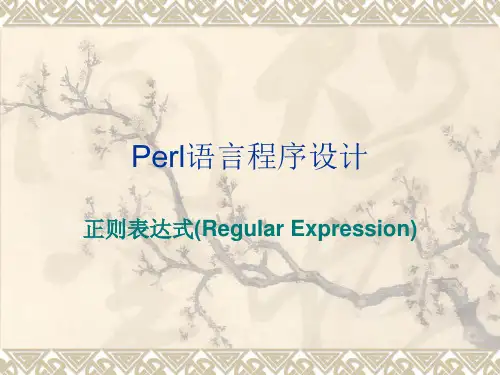
替换操作符的选项如下表: 选项 g i e m o s x 描述 改变模式中的所有匹配 忽略模式中的大小写 替换字符串作为表达式 将待匹配串视为多行 仅赋值一次 将待匹配串视为单行 忽略模式中的空白
注:e选项把替换部分的字符串看作表达式,在替换之前先计算其值,如: $string = "0abc1"; $string =~ s/[a-zA-Z]+/$& x 2/e; # now $string = "0abcabc1"
=~:检验匹配是否成功:$result = $var =~ /abc/;若在该字符串中找到了该 模式,则返回非零值,即true,不匹配 则返回0,即false。 !~:则相反。
这两个操作符适于条件控制中,如: if ($question =~ /please/) { print ("Thank you for being polite!\n"); } else { print ("That was not very polite!\n"); }
注:split函数每次遇到分割模式,总是开始 一个新单词。 (1)若$line以空格打头,则@array的第 一个元素即为空元素。但其可以区分是否真 有单词。 (2)若$line中只有空格,则@array则为 空数组。且上例中TAB字符被当作一个单词。 注意修正。
2、字符 [ ]和[^] [ ]:意味着匹配一组字符中的一个,如 /a[0123456789]c/将匹配a加数字加c的字符 串。与+联合使用例:/d[eE]+f/匹配def、dEf、 deef、dEf、dEEEeeeEef等。 ^:表示除其之外的所有字符,如: /d[^eE]f/匹配d加非e字符加f的字符串。 3、字符 *和? 它们与+类似,区别在于 *:匹配0个、1 个或多个相同字符,?:匹配0个或1个该字 符。如/de*f/匹配df、def、deeeef等; /de?f/匹配df或def。
20个常用的正则表达式 单字母
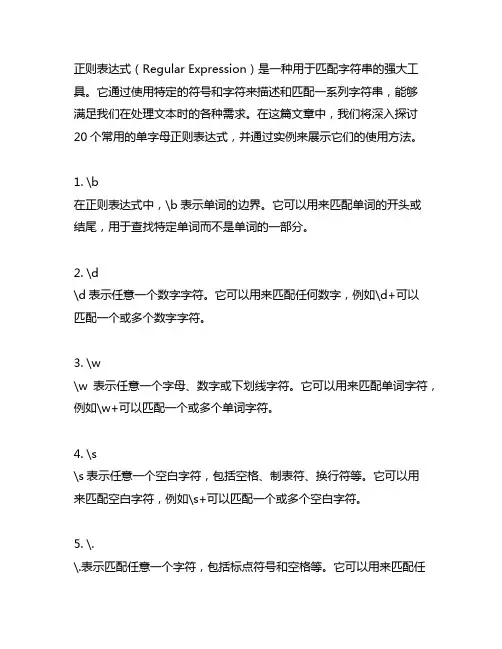
正则表达式(Regular Expression)是一种用于匹配字符串的强大工具。
它通过使用特定的符号和字符来描述和匹配一系列字符串,能够满足我们在处理文本时的各种需求。
在这篇文章中,我们将深入探讨20个常用的单字母正则表达式,并通过实例来展示它们的使用方法。
1. \b在正则表达式中,\b表示单词的边界。
它可以用来匹配单词的开头或结尾,用于查找特定单词而不是单词的一部分。
2. \d\d表示任意一个数字字符。
它可以用来匹配任何数字,例如\d+可以匹配一个或多个数字字符。
3. \w\w表示任意一个字母、数字或下划线字符。
它可以用来匹配单词字符,例如\w+可以匹配一个或多个单词字符。
4. \s\s表示任意一个空白字符,包括空格、制表符、换行符等。
它可以用来匹配空白字符,例如\s+可以匹配一个或多个空白字符。
5. \.\.表示匹配任意一个字符,包括标点符号和空格等。
它可以用来匹配任意字符,例如\.可以匹配任意一个字符。
6. \A\A表示匹配字符串的开始。
它可以用来确保匹配发生在字符串的开头。
7. \Z\Z表示匹配字符串的结束。
它可以用来确保匹配发生在字符串的结尾。
8. \b\b表示单词的边界。
它可以用来匹配单词的开头或结尾,用于查找特定单词而不是单词的一部分。
9. \D\D表示任意一个非数字字符。
它可以用来匹配任何非数字字符。
10. \W\W表示任意一个非单词字符。
它可以用来匹配任何非单词字符。
11. \S\S表示任意一个非空白字符。
它可以用来匹配任何非空白字符。
12. \[\[表示匹配方括号。
它可以用来匹配包含在方括号内的字符。
13. \]\]表示匹配方括号。
它可以用来匹配包含在方括号内的字符。
14. \(\(表示匹配左括号。
它可以用来匹配包含在左括号内的字符。
15. \)\)表示匹配右括号。
它可以用来匹配包含在右括号内的字符。
16. \{\{表示匹配左花括号。
它可以用来匹配包含在左花括号内的字符。
17. \}\}表示匹配右花括号。
regexp用法例子
regexp用法例子首先,正则表达式(Regular Expression)是一种在文本中查找特定模式的强大工具。
它们在各种场景中都有广泛的应用,包括但不限于模式匹配、替换、筛选等。
在本文中,我们将通过一些例子来展示如何使用正则表达式。
其次,正则表达式的语法因不同的操作系统和编程语言而异。
常用的编程语言如Python、JavaScript、Java等都有自己的正则表达式库。
一般来说,正则表达式由特殊字符和元字符组成,用于匹配和查找模式。
常见的正则表达式模式包括字符类、重复模式、分组等。
以下是一些使用正则表达式的例子:**例子1:在Python中使用正则表达式匹配电子邮件地址**```pythonimport repattern = r'[\w.-]+@[\w.-]+\.[\w.-]+'text = '我的电子邮件是*****************'matches = re.findall(pattern, text)print(matches) # 输出:['*****************']```这个例子展示了如何使用Python的正则表达式库来匹配电子邮件地址。
通过定义一个正则表达式模式,我们可以轻松地找到文本中的匹配项。
**例子2:在JavaScript中使用正则表达式替换字符串中的特定字符**```javascriptlet text = 'Hello, world!';let pattern = /o/g; // 匹配所有的o字符let replacement = '*'; // 将匹配到的字符替换为星号let newText = text.replace(pattern, replacement);console.log(newText); // 输出:'Hell*r*d!'```这个例子展示了如何使用JavaScript的正则表达式库来替换字符串中的特定字符。
VB6.0正则表达式
VB6.0如何使用正则表达式引用了Microsoft VBScript Regular Expressions 5.5 后就可以声明正则相关对象了。
主要有三个对象:RegExp、MatchCollection、Match。
1. RegExp这是VB使用正则表达式匹配模式的主要对象了。
其提供的属性用于设置那些用来比较的传递给RegExp 实例的字符串的模式。
其提供的方法以确定字符串是否与正则表达式的特定模式相匹配。
属性:Pattern:一个字符串,用来定义正则表达式。
IgnoreCase:,则忽略英文字母大小的匹配,False对大小写进行匹配。
Global:设置一个布尔值或返回一个布尔值,该布尔值指示一个模式是必须匹配整个搜索字符串中的所有搜索项还是只匹配第一个搜索项。
MultiLine:这个MS没有介绍。
查了一下资料,设置一个布尔值或返回一个布尔值,是否在串的多行中搜索。
如果允许匹配多行文本,则multiline为true,如果搜索必须在换行时停止,则为false 。
方法:Execute:返回一个MatchCollection 对象,该对象包含每个成功匹配的Match 对象。
Replace:MS没有介绍,这是返回一个将匹配字符替换为指定字符的字符串。
Test:返回一个布尔值,该值指示正则表达式是否与字符串成功匹配。
2.MatchCollection是集合对象,包含有关匹配字符串的信息,该对象包含每个成功匹配的Match 对象。
属性Count:匹配对象的总数。
Item:匹配对象的索引。
3.Match是成功匹配的对象。
属性:FirstIndex:匹配对象所匹配字符串的起始位置。
Length:匹配对象所匹配字符串的字符长度。
SubMatches:匹配对象所匹配结果的子项。
Value:匹配对象所匹配的值。
见下面的几个简单示例:1.匹配过程Function TestRegExp(myPattern As String, myString As String)Dim objRegExp As RegExp '定义对象Dim objMatch As MatchDim colMatches As MatchCollection '对象包含有关匹配字符串的信息Dim RetStr As StringSet objRegExp = New RegExpobjRegExp.Pattern = myPattern '传入参数,用来定义正则表达式objRegExp.IgnoreCase = TrueobjRegExp.Global = TrueIf objRegExp.Test(myString) Then '正则表达式与字符串成功匹配Set colMatches = objRegExp.Execute(myString)For Each objMatch In colMatchesRetStr = RetStr & "发现位置" & objMatch.FirstIndex & ". 匹配值是'" & objMatch.Value & "'." & vbCrLfNextElseRetStr = "String Matching Failed"End IfTestRegExp = RetStrEnd FunctionPrivate Sub Command1_Click()MsgBox (TestRegExp("is.", "ISss1 is2 IS3 is4"))End Sub2.RegExp的Test方法:Function bTest(ByVal s As String, ByVal p As String) As BooleanDim re As RegExpSet re = New RegExpre.IgnoreCase = False'设置是否匹配大小写re.Pattern = pbTest = re.Test(s)End FunctionPrivate Sub Command1_Click()Dim s As StringDim p As Strings = "我的邮箱: test@ 。
精华资料VB正则表达式
VB正则表达式简介如果原来没有使用过正则表达式,那么可能对这个术语和概念会不太熟悉。
不过,它们并不是您想象的那么新奇。
请回想一下在硬盘上是如何查找文件的。
您肯定会使用,?,和,*,字符来帮助查找您正寻找的文件。
?,字符匹配文件名中的单个字符,而,*,则匹配一个或多个字符。
一个如,'data?.dat',的模式可以找到下述文件:data1.datdata2.datdatax.datdataN.dat如果使用,*,字符代替,?,字符,则将扩大找到的文件数量。
'data*.dat',可以匹配下述所有文件名:data.datdata1.datdata2.datdata12.datdatax.datdataXYZ.dat尽管这种搜索文件的方法肯定很有用,但也十分有限。
?,和,*,通配符的有限能力可以使你对正则表达式能做什么有一个概念,不过正则表达式的功能更强大,也更灵活。
早期起源正则表达式的“祖先”可以一直上溯至对人类神经系统如何工作的早期研究。
Warren,McCulloc h,和,Walter,Pitts,这两位神经生理学家研究出一种数学方式来描述这些神经网络。
1956,年,,一位叫,Stephen,Kleene,的美国数学家在,McCulloch,和,Pitts,早期工作的基础上,发表了一篇标题为“神经网事件的表示法”的论文,引入了正则表达式的概念。
正则表达式就是用来描述他称为“正则集的代数”的表达式,因此采用“正则表达式”这个术语。
,随后,发现可以将这一工作应用于使用Ken,Thompson,的计算搜索算法的一些早期研究,Ke n,Thom pson是Unix,的主要发明人。
正则表达式的第一个实用应用程序就是,Unix,中的qed,编辑器。
如他们所说,剩下的就是众所周知的历史了。
从那时起直至现在正则表达式都是基于文本的编辑器和搜索工具中的一个重要部分。
使用正则表达式在典型的搜索和替换操作中,必须提供要查找的确切文字。
正则表达式用法详解
正则表达式⽤法详解正则表达式之基本概念在我们写页⾯时,往往需要对表单的数据⽐如账号、⾝份证号等进⾏验证,⽽最有效的、⽤的最多的便是使⽤正则表达式来验证。
那什么是正则表达式呢?正则表达式(Regular Expression)是⽤于描述⼀组字符串特征的模式,⽤来匹配特定的字符串。
它的应⽤⾮常⼴泛,特别是在字符串处理⽅⾯。
其常见的应⽤如下:验证字符串,即验证给定的字符串或⼦字符串是否符合指定的特征,例如,验证是否是合法的邮件地址、验证是否是合法的HTTP地址等等。
查找字符串,从给定的⽂本当中查找符合指定特征的字符串,这样⽐查找固定字符串更加灵活。
替换字符串,即查找到符合某特征的字符串之后将之替换。
提取字符串,即从给定的字符串中提取符合指定特征的⼦字符串。
第⼀部分:正则表达式之⼯具正所谓⼯欲善其事必先利其器! 所以我们需要知道下⾯⼏个主要的⼯具:第⼆部分:正则表达式之元字符正则表达式中元字符恐怕是我们听得最多的了。
元字符(Metacharacter)是⼀类⾮常特殊的字符,它能够匹配⼀个位置或者字符集合中的⼀个字符。
如.、\w等都是元字符。
刚刚说到,元字符既可以匹配位置,也可以匹配字符,那么我们就可以通过此来将元字符分为匹配位置的元字符和匹配字符的元字符。
A匹配位置的元字符---^、$、\b即匹配位置的元字符只有^(脱字符号)、$(美元符号)和\b这三个字符。
分别匹配⾏的开始、⾏的结尾以及单词的开始或结尾。
它们匹配的都只是位置。
1.^匹配⾏的开始位置如^zzw匹配的是以"zzw"为⾏开头的"zzw"(注意:我这⾥想要表达的是:尽管加了⼀个^,它匹配的仍是字符串,⽽不是⼀整⾏!),如果zzw不是作为⾏开头的字符串,则它不会被匹配。
2.$匹配⾏的结尾位置如zzw$匹配的是以"zzw"为⾏结尾的"zzw"(同样,这⾥$只是匹配的⼀个位置,那个位置是零宽度,⽽不是⼀整⾏),如果zzw不是作为⾏的结尾,那么它不会被匹配。
- 1、下载文档前请自行甄别文档内容的完整性,平台不提供额外的编辑、内容补充、找答案等附加服务。
- 2、"仅部分预览"的文档,不可在线预览部分如存在完整性等问题,可反馈申请退款(可完整预览的文档不适用该条件!)。
- 3、如文档侵犯您的权益,请联系客服反馈,我们会尽快为您处理(人工客服工作时间:9:00-18:30)。
VS SDK Regular Expression Language Service Example Deep Dive (VB)István Novák (DiveDeeper), Grepton Ltd.May, 2008IntroductionThis example implements a small language service for demonstration purposes. This is called Regular Expression Language Service since it can tokenize text by RegEx patterns (lower case letters, capital letters, digits) and can use its own syntax coloring scheme for each token. However, the functionality of this sample is quite far away from a full language service it illustrates the basics. The source files belonging to this code have only about three hundred lines of essential code. When reading through this deep dive you are going to get familiar with the following concepts: How language services should be registered with Visual Studio?What kind of lifecycle management tasks a simple language service has?How to create a very simple language service?How to implement a scanner supporting syntax coloring?To understand concepts treated here it is assumed that you are familiar with the idea of VSPackages and you know how to build and register very simple (even non-functional) packages. To get more information about packages, please have a look at the Package Reference Sample (VisualBasic Reference.Package sample). Very basic knowledge about regular expressions is also expected.Regular Expression Language ServiceOpen the Microsoft Visual Studio 2008 SDK Browser and select the Samples tab. In the top middle list you can search for the “VisualBasic Example.RegExLangServ” sample. Please, use the “Open this sample in Visual Studio” link at the top right panel of the browser app to prepare the sample. The application opens in Visual Studio 2008.Running the sampleRebuild the package and start it with the Experimental Hive! Without creating a new solution, add a new text file with the File|New|File... menu function. Use theFile|Save As menu function to store the text file with the RegexFile.rgx name. To avoid attaching the .txt extension to the end of the file name, set the “Save as type” to “All files (*.*)” as illustrated in Figure 1:Figure 1: Save the file with .rgx extensionType a few words, number and punctuation characters into the editor and see how they are colored! You can see an illustration in Figure 2:Figure 2: Our language service has effect on syntax coloringNow, try to save the file again with the File|Save As menu function. This time the Sav e As dialog contains the “RegEx File (*.rgx)” in its “Save as type” field indicating that it recognizes this file type with .rgx extension.The structure of the sampleThe solution contains a VSPackage project named RegExLangServ that uses a few reference assemblies for VS interop starting with name “Microsoft.VisualStudio”. The project’s source files are the following:The essential code of this sample is in the RegExLangServ.vb, RegExScanner.vb and VsPkg.vb files; in the next scenarios I focus on them. In code extracts used in this deep dive I will omit or change comments to support better readability and remove using clauses, namespace declarations or other non-relevant elements. Scenario: Registering the Language Service with an associated file extensionThe language service this sample implements is intended to be used by Visual Studio Shell and by any other third party packages that want to use the functionality of the service. For example, the code window of Visual Studio uses this service for syntax coloring. Just as for any other services a language service also has to be registered with Visual Studio. The registration information is provided by attributes decorating the package class (VsPkg.vb):<ProvideLanguageExtension(GetType(RegularExpressionLanguageService), ".rgx")> _ <ProvideService(GetType(RegularExpressionLanguageService))> _' --- Other attributes omittedPublic NotInheritable Class RegularExpressionLanguageServicePackageInherits Shell.PackageImplements IDisposable' ...End ClassPlease note, there are a few attributes not indicated in the code extract above. If you are not familiar with them, take a look at the Package Reference Sample Deep Dive. Language service registration uses the following two attributes:With these attributes we registered the regular expression language service. However to use the service we have to take care of service instantiation. Scenario: Lifecycle management of a language serviceJust as in case of other local or proffered services, our package must manage the lifecycle of the regular expression language service. For most services created with the Managed Package Framework lifecycle management is about creating the service instance. For language services we must take care of the cleanup process, since at the back language services use unmanaged code and unmanaged resources. Our package class uses the standard pattern for managing the lifecycle of the language service instance:Public NotInheritable Class RegularExpressionLanguageServicePackageInherits Shell.PackageImplements IDisposablePrivate langService As RegularExpressionLanguageServiceProtected Overrides Sub Initialize()MyBase.Initialize()langService = New RegularExpressionLanguageService()langService.SetSite(Me)Dim sc As IServiceContainer = CType(Me, IServiceContainer)sc.AddService(GetType(RegularExpressionLanguageService), langService, True)End SubProtected Overrides Overloads Sub Dispose(ByVal disposing As Boolean) TryIf disposing ThenIf langService IsNot Nothing ThenlangService.Dispose()End IfEnd IfFinallyMyBase.Dispose(disposing)End TryEnd SubPublic Sub Dispos() Implements IDisposable.DisposeDispose(True)GC.SuppressFinalize(Me)End SubEnd ClassSince our package’s goal is to provide the regular expression language service, if our package gets loaded into the memory and sited (this is the time when the overridden Initialize method is called), we instantly create the service instance. The language service gets sited in our package and then added to the package’s service container and also promoted to the parent container.In the overridden Dispose method we release the resources held by the language service then clean up the other resources held by the package. The overridden Dispose is called from public Dispose that is implicit implementation of the IDisposable interface. Since our package is cleaned up here, we must use the GC.SuppressFinalize method call to avoid double cleanup of the package instance. The lifecycle management pattern used here should be applied for your own language services.Scenario: Implementing a small language serviceThe code editor built in Visual Studio can be customized by language services. This customization features include brace matching, syntax coloring, IntelliSence and many others. In order the code editor can leverage on a language service, it must access a few functions of them.Such kind of function is the access to the so-called scanner and the parser of the language service. The scanner is responsible for retrieving tokens like keywords, identifiers, double precision numbers, strings, comments and many others from the source text. The parser is responsible to understand what the sequence of tokens means, whether it matches with the expected language syntax, and so on.Syntax coloring basically uses only the scanner, but can use the parser, for example to use different colors for value and reference types. Brace matching generally uses the parser to find the matching pairs of opening and closing braces.In this example we use a small language service based on regular expressions that use only the scanner for syntax coloring and no parser for more complex tasks.To be a language service, we must create a COM object implementing a few interfaces with the IVsLanguage prefix in their names. The Managed Package Framework provides the LanguageService class that is the best type to start with instead of implementing the interfaces from scratch. To create a language service of our own, we must create a LanguageService derived class and override a few methods as the following code extract shows:<ComVisible(True)> _<Guid("C674518A-3127-4f00-9C4D-BE0EAAB8C761")> _Friend Class RegularExpressionLanguageServiceInherits LanguageServicePrivate scanner As RegularExpressionScannerPrivate preference As LanguagePreferencesPublic Overrides Function ParseSource(ByVal req As ParseRequest) As AuthoringScopeThrow New NotImplementedException()End FunctionPublic Overrides ReadOnly Property Name() As StringGetReturn "Regular Expression Language Service"End GetEnd PropertyPublic Overrides Function GetFormatFilterList() As StringReturn VSPackage.RegExFormatFilterEnd FunctionPublic Overrides Function GetScanner(ByVal buffer As _Microsoft.VisualStudio.TextManager.Interop.IVsTextLines) As IScannerIf scanner Is Nothing Thenscanner = New RegularExpressionScanner()End IfReturn scannerEnd FunctionPublic Overrides Function GetLanguagePreferences() As LanguagePreferencesIf preference Is Nothing Thenpreference = New LanguagePreferences(Me.Site,GetType(RegularExpressionLanguageService).GUID, _"Regular Expression Language Service")End IfReturn preferenceEnd FunctionEnd Class(This is the full code of the class; I have only changed indenting and omitted comments.)Our RegularExpressionLanguageService must be visible by COM and so must have an explicit GUID. The overridden Name property is used to obtain the name ofour language service. The GetFormatFilterList method retrieves the file filter expression u sed by the Save As dialog (“RegEx File (*.rgx)”).The overridden ParseSource method is to parse the specified source code according to a ParseRequest instance. Since our language service does not implement a parser, we throw a NotImplementedException here.Visual Studio supports language preference settings. Such kind of preference is for example IntelliSense support (supported or not), line numbers (should be displayed or not), the tab size used by the language and so on. By overriding the GetLanguagePreferences method we can tell what preferences are used by our service. In this implementation we use the default settings.The GetScanner method is the most important one in our language service. This method retrieves an object implementing the IScanner interface. As its name suggests, the returned object represents the scanner used to tokenize the source code text. The responsibility of a scanner object is delegated to a RegularExpressionScanner instance I treat in the next scenario.Scenario: Creating the scanner to support syntax coloring The scanner object is crucial for our regular expression language service. It implements the IScanner interface that has only two methods:Public Interface IScannerSub SetSource (source As String, offset As Integer)Function ScanTokenAndProvideInfoAboutIt (tokenInfo As TokenInfo, _ByRef state As Integer) As BooleanEnd InterfaceThe SetSource method is used to set a line to be parsed and also an offset is provided to start the parsing from. The ScanTokenAndProvideInfoAboutIt method is to obtain the next token from the currently parsed line. The TokenInfo parameter passed in is a structure to be filled up by the method, this represents the token scanned. The state parameter is an integer value representing the scanner state (it is used for so-called context-dependent scanning).The RegularExpressionScanner class implements this interface:Friend Class RegularExpressionScannerImplements IScannerPrivate sourceString As StringPrivate currentPos As IntegerPrivate Shared patternTable As RegularExpressionTableEntry() = _New RegularExpressionTableEntry(3) _{ _New RegularExpressionTableEntry("[A-Z]?", ment), _ New RegularExpressionTableEntry("[a-z]?", TokenColor.Keyword), _ New RegularExpressionTableEntry("[0-9]?", TokenColor.Number), _New RegularExpressionTableEntry(".", TokenColor.Text) _}Private Shared Sub MatchRegEx(ByVal source As String, ByRef charsMatched As Integer, _ByRef color As TokenColor)' --- Implementation omitted from this code extractEnd SubPublic Function ScanTokenAndProvideInfoAboutIt(ByVal tokenInfo As TokenInfo, _ByRef state As Integer) As Boolean _Implements IScanner.ScanTokenAndProvideInfoAboutItIf sourceString.Length = 0 ThenReturn FalseEnd IfDim color As TokenColor = TokenColor.TextDim charsMatched As Integer = 0MatchRegEx(sourceString, charsMatched, color)If tokenInfo IsNot Nothing ThentokenInfo.Color = colortokenInfo.Type = TokenType.TexttokenInfo.StartIndex = currentPostokenInfo.EndIndex = Math.Max(currentPos, currentPos + charsMatched - 1)End IfcurrentPos += charsMatchedsourceString = sourceString.Substring(charsMatched)Return TrueEnd FunctionPublic Sub SetSource(ByVal source As String, ByVal offset As Integer) _Implements IScanner.SetSourcesourceString = sourcecurrentPos = offsetEnd SubEnd ClassThe implementation of the SetSource method is trivial. The ScanTokenAndProvideInfoAboutIt method uses MatchRegEx to obtain the next token. According to the token it retrieves the TokenInfo structure is filled up and the position where the next token starts is set.The scanner defines a nested class called RegularExpressionTableEntry that describes a token represented by a RegEx and also assigns a token color to it. The static patternTable array demonstrates how this structure is set up. The MatchRegEx method uses this array to obtain the next token.SummaryThe Regular Expression Language Service sample demonstrates how easy is to create a very simple language service. In this case, the service created here implements a scanner that is able to tokenize the source text according to regular expression patterns. The language service also supports syntax coloring: each token accepted has a distinguishing color.Language services must be registered in order to be accessible by the VS Shell and third party packages. With a simple decorating attribute on the package owning a language service it can be associated with a file extension. When the file with the specified extension is opened in the code editor the corresponding language service is used to edit it.。
